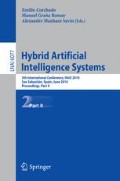Abstract
Color constancy and chromatic edge detection are fundamental problems in artificial vision. In this paper we present a way to provide a visualization of color constancy that works well even in dark scenes where such humans and computer vision algorithms have hard problems due to the noise. The method is an hybrid and non linear transform of the RGB image based on the assignment of the chromatic angle as the luminosity value in the HSV space. This chromatic angle is defined on the basis of the dichromatic reflection model, having thus a physical model supporting it.
This work been supported by Ministerio de Ciencia e Innovación of Spain TIN2009-05736-E/TIN.
Access this chapter
Tax calculation will be finalised at checkout
Purchases are for personal use only
Preview
Unable to display preview. Download preview PDF.
References
Barbur, J.L., Spang, K.: Colour constancy and conscious perception of changes of illuminant. Neuropsychologia 46, 853–863 (2008); PMID: 18206187
Cheng, H.D., Jiang, X.H., Sun, Y., Wang, J.: Color image segmentation: advances and prospects. Pattern Recognition 34(12), 2259–2281 (2001)
Garcia-Sebastian, M., Gonzalez, A.I., Grana, M.: An adaptive field rule for non-parametric mri intensity inhomogeneity estimation algorithm. Neurocomputing 72(16-18), 3556–3569 (2009); Financial Engineering; Computational and Ambient Intelligence (IWANN 2007)
Gijsenij, A., Gevers, T., van de Weijer, J.: Generalized gamut mapping using image derivative structures for color constancy. International Journal of Computer Vision 86(2), 127–139 (2010)
Graña, M., Torrealdea, F.J.: Hierarchically structured systems. European Journal of Operational Research 25, 20–26 (1986)
Choi, Y.-J., Yoon, K.-J., Kweon, I.S.: Illuminant chromaticity estimation using dichromatic slope and dichromatic line space. In: Korea-Japan Joint Workshop on Frontiers of Computer Vision, FCV, pp. 219–224 (2005)
Lezoray, O., Charrier, C.: Color image segmentation using morphological clustering and fusion with automatic scale selection. Pattern Recognition Letters 30(4), 397–406 (2009)
Shafer, S.A.: Using color to separate reflection components. Color Research and Aplications 10, 43–51 (1984)
Shen, H.-L., Zhang, H.-G., Shao, S.-J., Xin, J.H.: Chromaticity-based separation of reflection components in a single image. Pattern Recognition 41, 2461–2469 (2008)
Skaff, S., Arbel, T., Clark, J.J.: A sequential bayesian approach to color constancy using non-uniform filters. Computer Vision and Image Understanding 113(9), 993–1004 (2009)
Tan, R.T., Nishino, K., Ikeuchi, K.: Color constancy through inverse-intensity chromaticity space. J. Opt. Soc. Am. A Opt. Image Sci. Vis. 21(3), 321–334 (2004)
Tan, R.T., Nishino, K., Ikeuchi, K.: Separating reflection components based on chromaticity and noise analysis. IEEE Trans. Pattern Anal. Mach. Intell. 26(10), 1373–1379 (2004)
Tan, R.T., Ikeuchi, K.: Reflection components decomposition of textured surfaces using linear basis functions. In: IEEE Computer Society Conference on Computer Vision and Pattern Recognition, CVPR 2005, June 20-25, vol. 1, pp. 125–131 (2005)
Tan, T.T., Nishino, K., Ikeuchi, K.: Illumination chromaticity estimation using inverse-intensity chromaticity space. In: Proceedings of 2003 IEEE Computer Society Conference on Computer Vision and Pattern Recognition, June 18-20, vol. 1, pp. I-673–I-680 (2003)
Yoon, K.-J., Chofi, Y.J., Kweon, I.-S.: Dichromatic-based color constancy using dichromatic slope and dichromatic line space. In: IEEE International Conference on Image Processing, ICIP 2005, September 11-14, vol. 3, pp. III–960–3 (2005)
Yoon, K.-J., Choi, Y., Kweon, I.S.: Fast separation of reflection components using a specularity-invariant image representation. In: IEEE International Conference on Image Processing, October 8-11, pp. 973–976 (2006)
Author information
Authors and Affiliations
Editor information
Editors and Affiliations
Rights and permissions
Copyright information
© 2010 Springer-Verlag Berlin Heidelberg
About this paper
Cite this paper
Moreno, R., López-Guede, J.M., d’Anjou, A. (2010). Hybrid Color Space Transformation to Visualize Color Constancy. In: Corchado, E., Graña Romay, M., Manhaes Savio, A. (eds) Hybrid Artificial Intelligence Systems. HAIS 2010. Lecture Notes in Computer Science(), vol 6077. Springer, Berlin, Heidelberg. https://doi.org/10.1007/978-3-642-13803-4_30
Download citation
DOI: https://doi.org/10.1007/978-3-642-13803-4_30
Publisher Name: Springer, Berlin, Heidelberg
Print ISBN: 978-3-642-13802-7
Online ISBN: 978-3-642-13803-4
eBook Packages: Computer ScienceComputer Science (R0)

